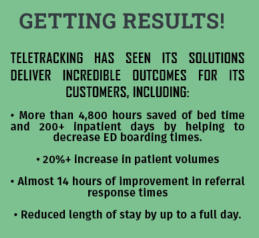TeleTracking is Redefining Health Care
by Sheena Carroll
.jpg) Anita Dressel’s career journey has been a bit unusual, but also one that she wouldn’t change for anything.
Anita Dressel’s career journey has been a bit unusual, but also one that she wouldn’t change for anything.
“I like to say that I was lucky to have found TeleTracking six years ago, but in reality, I think TeleTracking found me,” said Dressel.
Dressel graduated from the University of Pittsburgh with a degree in electrical engineering and started her career as an engineer, transitioning through roles from pre-sales to post sales, ultimately running business operations, and then bringing her business knowledge to lead finance and drive value creation. As she progressed through her early career with Ericsson, she was given the opportunity to take on a role in Stockholm, Sweden, starting as the Head of Business Control & Commercial Management, and ultimately serving as CFO of a multi-billion-dollar business unit.
After nine years in Stockholm and when her eldest child was ready to graduate high school, Dressel and her family decided the time was right to return to the United States. That’s when she met the owner of TeleTracking. It was a perfect fit from the start; she joined first as CFO, then started running Operations, and now she serves as President.
“As the daughter of an Emergency Room physician, I’ve always had a passion for health care and a deep-rooted desire to be part of it in some way,” said Dressel. “My interest was initially to pursue a medical degree, but with all of the challenges in health care, my parents steered me away. I found my way back to my true passion with TeleTracking and our mission to ‘ensure that no one ever waits for the care that they need’. I take great pride in the fact that we are helping to solve a global problem by reducing waste in health care and helping our partners expand their capacity to care so they can deliver greater care to more patients in need.”
Dressel is proud that TeleTracking is redefining what it means to manage health care effectively, evolving with the ever-increasing complexity in the industry. The company has evolved from a telephone-based system to an advanced SaaS-based platform managing workflows and using automation, data, analytics and artificial intelligence to optimize access to care, streamline care delivery and connect the transitions of care.
“We see the same needs right here in our hometown of Pittsburgh and are proud to be serving our local health systems, the same systems that care for our own families and loved ones.”
On the Horizon
TeleTracking’s full transition to a SaaS platform has unlocked the ability for the company to innovate faster and deliver a more feature-rich experience for their customers.
The company has recently launched Workflow IQ®, with the initial focus on the perioperative space, evolving next to multi-modal clinics, and ultimately available for the entire spectrum of operational care settings.
They’ve also been working on integrating artificial intelligence-based decision-making functionality into the platform.
”Our solution is a mission critical application for our clients, and we take that responsibility very seriously,” said Dressel. “Safety is at the core of our development, ensuring that we provide robust proven solutions that provide real impact.”
Looking to the future
 Dressel explained that the health care industry has been shifting from individual, independent hospitals to health systems, that will ultimately move to market ecosystems. Additionally, the delivery of care is becoming increasingly fragmented, with more care being delivered outside the four walls of the hospital.
Dressel explained that the health care industry has been shifting from individual, independent hospitals to health systems, that will ultimately move to market ecosystems. Additionally, the delivery of care is becoming increasingly fragmented, with more care being delivered outside the four walls of the hospital.
With this shift comes the demand for system-wide visibility to capacity, centralized placement capabilities, as well as the increasing need for better data, analytics and benchmarking.
“We view health care at a macro level and are making it possible for health systems to develop full operational visibility across their enterprise, including regional partners - owned or affiliated,” said Dressel. “We are also enabling seamless transitions between different care settings, to bridge the gaps that exist today and connect the disconnected components.
“Additionally, the cognitive load on scarce front line care givers is ever increasing and must be addressed. We are evolving our solutions to reduce this load by facilitating interoperability with the EMR, automating manual tasks and discharge workflows, as well as improving and simplifying decision making with real time data, analytics and artificial intelligence.”
In the coming decades, Dressel predicts that the industry will move to technology solutions that further support the cognitive load of caregivers by finding ways to reduce staff burnout.
“Patient volumes continue to increase while the number of skilled caregivers moves in the opposite direction, we as an industry need to find new, creative ways to not only serve the patient population, but also expand that capacity without increasing the need for additional resources.”
Looking at a macro level, more and more patients receive care outside the hospital. This means that additional capacity, in some cases, comes from non-traditional care settings like virtual care and telemedicine, hospital-at-home, or outpatient and post-acute settings.
“We see an evolution in the way hospitals want to use the technology they have today and in what they will need it to do for them in the future. The changes that we see in the industry drive TeleTracking to continuously evolve our solutions to meet those needs.”